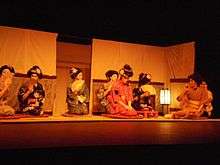Za Kabuki
Za Kabuki (Japanese: ザ歌舞伎), founded in 1976 at the Australian National University, is the longest running Kabuki troupe outside Japan.[1] Directed by Shun Ikeda of the ANU Japan Centre, with a cast and crew consisting mainly of ANU Japanese students,[2] the troupe performs traditional Kabuki plays almost entirely in classical Japanese, with some English translation and ad-libs inserted to assist the mainly English-speaking audiences.[3]

History
The tradition of annual Japanese performances at the ANU began in 1976,[4] with the first shows taking place in the walkway between the Sports & Recreation building and the Union building. During the 1980s and 1990s, productions became increasingly elaborate, with authentic makeup and costumes, original sets and musical accompaniment, hosted at a number of the theatre facilities around the ANU campus.
In 1999, Producer Suzy Styles led the Za Kabuki troupe on their first tour of Japan, with performances in Nara and Kobe. On 11 September 2001, a troupe from Kobe's Konan University returned the favour by performing at the ANU's Llewellyn Hall.
The 2006 production of Yukio Mishima's Iwashiuri Koi no Hikiami, for the first time in Za Kabuki history, featured a 7-piece orchestra, also made up predominantly of ANU Japan Centre students. The orchestra played an original score, composed specifically for the play by Thomas Spencer Hartley.
2013 marked Za Kabuki's first performance in the absence of long-time director, Shun Ikeda. Instead the role of director was taken on by third-year ANU student and former kuroko, Noriyuki Yabe. Despite the timing of the performance coinciding with exam period, the 2013 performance of Kagotsurube managed to sell over four hundred tickets in a twenty-four-hour period and was greatly praised by critics.
In 2016, the crew once again travelled to Japan, performing three shows in the Tohoku region, particularly in areas affected by the 2011 Earthquake and Tsunami. The tour was highly successful and deepened ties between the club and communities in Akita, Kesennuma and Ishinomaki.
In 2017, the group conducted a performance tour in Melbourne, performing 'Topknot Bunshichi' at two venues. The shows were received well and preceded two sell-out nights in Canberra in early October.
Past performances
| Year | Title | English title | Author | Producer | Director |
|---|---|---|---|---|---|
| 2017 | Ninjou Banashi Bunshichi Mottoi | Topknot Bunshichi | Enokido Kenji | Erin McCullagh, Marika Kirton | Shun Ikeda |
| 2016 | Iwashi Uri Koi Hikiami | The Sardine Seller's Net of Love | Yukio Mishima | Erin McCullagh, Alexander Joske | Shun Ikeda |
| 2015 | Kumo ni Magou Ueno no Hatsuhana | Kochiyama The Extortionist | Kawatake Shinshichi II | Esther Soh, Tierney Boel | Shun Ikeda |
| 2014 | Sukeroku | Sukeroku | Tsuuchi Jihei II, Tsuuchi Han'emon (adapted by Joshua Pako) | Naomi Holm, Cianne So Yun Jeong | Shun Ikeda |
| 2013 | Kagotsurube Sato No Eizame | Kagotsurube The Haunted Sword | Kawatake Shinshichi III | Jia Eon Cheng, Katherine Zhou | Nori Yabe |
| 2012 | Kenuki | The Whisker Tweezers | Nakata Mansuke | Masaya Kimura | Shun Ikeda |
| 2011 | Iwashi Uri Koi Hikiami | The Sardine Seller's Net of Love | Yukio Mishima | Dia Jalil | Shun Ikeda |
| 2010 | Bunshichi Motoyui Ninjyou Banashi | Topnot Bunshichi: A Story of Human Relations | Enokido Kenji | Kaima Negishi, Haru Depp | Shun Ikeda |
| 2009 | Ise Ondo Koi no Netaba | Dancing with a Sleeping Blade | Chikamatsu Tokuzo | Rachael McAndrew | Shun Ikeda |
| 2008 | Hakata Kojoro Namimakura | Love At Sea | Chikamatsu Monzaemon | Michiko Takimoto | Masafumi Matsumoto |
| 2007 | Kanadehon Chushingura | The Treasury of Loyal Retainers | Takeda Izumo | Elli Kim | Shun Ikeda |
| 2006 | Iwashiuri Koi no Hikiami | Sardine Seller Casts The Net of Love | Yukio Mishima | Irene Abarquez | Shun Ikeda |
| 2005 | Shinju Ten no Amijima | The Love Suicides at Amijima | Chikamatsu Monzaemon | Will Mitchell / Peri Jenkins | Shun Ikeda |
| 2004 | Koi no Tayori Yamato Oorai | The Courier for Hell | Chikamatsu Monzaemon | ? | Shun Ikeda |
| 2003 | Ninjo Banashi Bunshichi Motoyui | Topknot Bunshichi: A Tale of Human Relations | Enokido Kenji | Stephen Harrington | Shun Ikeda |
| 2002 | Iwashiuri Koi no Hikiami | Catching a Fish Called Love | Yukio Mishima | Catherine Bailey | Shun Ikeda |
| 2001 | Kanadehon Chūshingura (7-dan-me) | The Legend of the 47 Ronin (Act 7) | Takeda Izumo | ? | Shun Ikeda |
References
- Negishi, K & Tomoeda, M. (2010). ANU ZA Kabuki. Monsoon (pg. 26). Australian National University Asia Pacific Studies Society.
- http://www.anuexchange.net/event.php?eid=13
- ANU Za Kabuki Club. "The 36th annual Japanese evening featuring Za Kabuki 2013". anu.edu.au. Retrieved 14 March 2018.
- "Who We Are - Za Kabuki 2013". sites.google.com. Retrieved 14 March 2018.